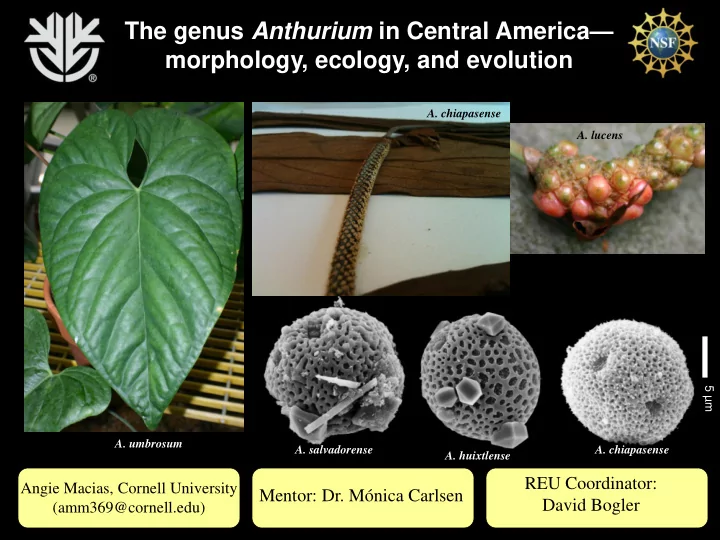

The genus Anthurium in Central America — morphology, ecology, and evolution A. chiapasense A. lucens 5 µm A. umbrosum A. salvadorense A. chiapasense A. huixtlense REU Coordinator: Angie Macias, Cornell University Mentor: Dr. Mónica Carlsen David Bogler (amm369@cornell.edu)
Outline Introduction • Pollen • Lucid Key A. verapazense • Species Distribution Models • Conclusion A. pedatoradiatum
Introduction • Neotropical genus in family Araceae • Est. 1000 species, 912 currently described • Morphology extremely variable http://www.geoware-online.com/maps.html
Introduction Clade 16 • Anthurium was divided into 18 sections (Croat & Sheffer 1983) • Molecular phylogeny sampling ~11% of species (Carlsen & Clade Croat 2013) 4 • Three clades are restricted to Central America, others are more widespread Clade A
Introduction A. chiapasense A. chiapasense A. clarinervium A. berriozabalense A. clidemioides A. podophyllum A. huixtlense A. verapazense A. guatemalense
Objectives 1. Examine pollen to look for characters that provide morphological evidence for the molecular phylogeny. 2. Produce a Lucid Key for the group of Anthurium species endemic to Central America. 3. Identify differences in ecological preferences between species and/or clades.
Outline • Introduction Pollen • Lucid Key • Species Distribution Models 5 µm • Conclusion A. lezamae
Methods 1. Collect pollen from 16 species in the Missouri Botanical Garden greenhouses 2. Prepare samples for and view in SEM 3. Describe pollen characters for each species The Missouri Botanical Garden SEM
Results A. berriozabalense A. huixtlense • Strange crystals! S • Some are certainly 5 µm calcium oxalate Some are Others are attached embedded in because of their to pollen… the outer crystal structure layer… • Most are unknown 5 µm 1 µm 5 µm 20 µm And more are “free”…
Results • Gemmate exine ornamentation occurs in Clade A • Spiny, reticulate “criss - cross” ornamentation occurs in Clade 4 • Fine reticulation with A. clidemioides, Clade A A. verapazense, Clade 4 smooth walls and apparent (Grayum 1992) apertures occur in Clade 16 (most similar to outgroups) 5 µm • Other Anthurium species have reticulation, but holes are usually larger. A. salvadorense, Clade 9 A. podophyllum, Clade 16 (outgroup)
Outline • Introduction • Pollen Lucid Key • Species Distribution Models • Conclusion A. salvadorense
Methods • Revise Lucid Key developed originally by Tom Croat • Scored 92 characters for 47 species (184 herbarium specimens) from Central America • Also scored 16 living species, but data still incomplete • Look through literature to find detailed taxonomic descriptions of the species Herbarium specimen of Anthurium yetlense
But what is a Lucid Key? • Digital keys that aid in species identification • Allow users to select the characters they want to use instead of following those chosen in a dichotomous key • Good for plant groups with many species and many important characters
Raw Data
Lucid
Lucid
Outline • Introduction • Pollen • Lucid Key Species Distribution Models • Conclusion www.maps.google.com
Methods Observed specimens • Collect localities and coordinates for 56 species (~5800 specimens) through TROPICOS and georeferencing A. andicola • Clean data Model: • Use MaxEnt & Probability of Occurrence DivaGIS to produce Key distribution models Absent Low probability Medium probability High probability
Results Clade 4 Clade A E S Clade 16 Key Absent Low richness Medium richness High richness W
Outline • Introduction • Pollen • Lucid Key • Species Distribution Models Conclusion A. verapazense
Conclusion • In general, the three clades restricted to Central America (Clade A-section Polyphyllium , Clade 4, and Clade 16- Anthurium andicola alliance) (Carlsen & Croat 2013) are very distinct from each other, and from other more widespread groups, in their overall morphology and ecological needs.
Conclusion • All the programs used (Lucid, DivaGIS, MaxEnt) are freely available online • All the results will be freely available online! -Pollen images: PalDat -Lucid Key: Kew eMonocots webpage -Species Distribution Models: Smithsonian
Acknowledgements A. clarinervium • MBG • NSF • Mónica Carlsen • David Bogler • Tom Croat • Justin Zweck • Erika Belmont • MBG Library • CCSD (esp. Adam Smith) Flickr, CC license
Thanks for listening! • My email address is amm369@cornell.edu if you have any questions! Missouri Botanical Garden, Araceae greenhouse
Recommend
More recommend